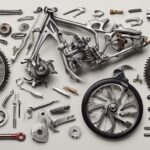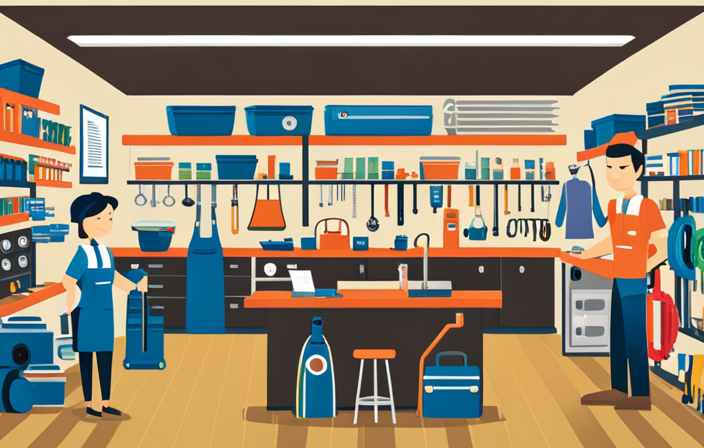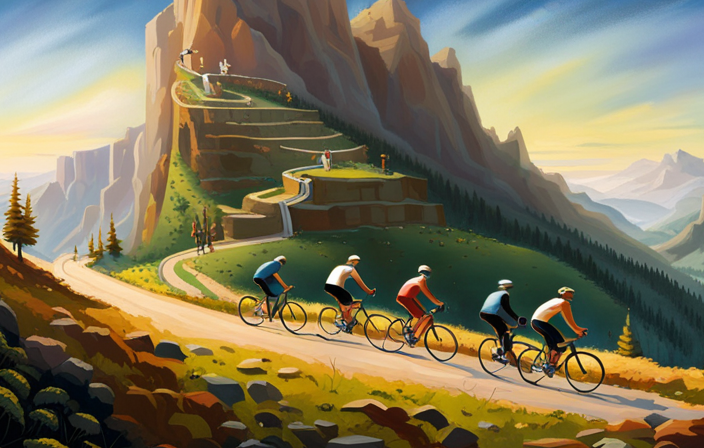I love riding my electric bike – it’s an exhilarating and eco-friendly way to get around.
If you’re new to electric bikes or looking to enhance your skills, this article is for you. In this guide, I’ll walk you through everything you need to know about electric bikes: from understanding the different types, to choosing the right one for you, and even upgrading and customizing your ride.
So, let’s dive in and explore the world of electric biking together!
Key Takeaways
- There are two types of electric bike motors: hub motors and mid-drive motors.
- The power output of an electric bike determines the level of assistance it provides.
- When choosing an electric bike, consider factors such as riding style, terrain, and wattage.
- Familiarize yourself with the controls and features of the electric bike, including adjusting the seat height, brakes, gears, battery level indicator, and power assist modes.
Understanding the Different Types of Electric Bikes
If you’re interested in electric bikes, it’s important for you to understand the different types available. One key factor to consider when choosing the right electric bike is the motor. Electric bikes typically come with two types of motors: hub motors and mid-drive motors.
Hub motors are located in the wheels, either in the front or rear, and provide a more balanced weight distribution. On the other hand, mid-drive motors are situated near the bottom bracket and offer better power transfer and control.
Another important aspect to consider is the power output of the electric bike. Power output is measured in watts and determines how much assistance the motor provides. Higher wattage means more power and faster acceleration. However, it’s crucial to keep in mind that higher power output may result in reduced battery life.
Understanding the different types of electric bikes and the importance of choosing the right motor and power output will help you make an informed decision. By considering your specific needs and preferences, you can find an electric bike that suits you perfectly.
In the next section, we will explore the process of choosing the right electric bike for you, taking into account factors such as riding style, terrain, and budget.
Choosing the Right Electric Bike for You
When choosing the right e-bike for you, it’s important to consider factors such as your riding style and terrain preferences. Understanding e-bike specifications and comparing e-bike brands can help you make an informed decision. Here are three key points to keep in mind:
-
Motor Power: The motor power determines how much assistance you will get while pedaling. Higher wattage motors provide more power, making them suitable for hilly terrains or riders who need extra assistance. Lower wattage motors are better for flat terrains or riders who prefer a more natural riding experience.
-
Battery Capacity: The battery capacity determines how far you can ride on a single charge. Consider your typical riding distance and choose a battery with enough capacity to meet your needs. Keep in mind that factors such as terrain, rider weight, and assist level can affect battery life.
-
Frame Type: E-bikes come in various frame types, including step-through, mountain, and hybrid. Choose a frame type that suits your riding style and comfort preferences. Step-through frames are easier to mount and dismount, making them suitable for city commuting. Mountain frames are more rugged and designed for off-road adventures. Hybrid frames offer a balance between the two.
Getting Familiar with the Controls and Features
To get familiar with the controls and features, start by adjusting the seat height to ensure a comfortable riding position. Once you’ve done that, it’s time to explore the other important aspects of your electric bike. One of the key areas to focus on is brake adjustment. Properly adjusted brakes are crucial for a safe and smooth ride. Make sure the brake levers are within easy reach of your hands and that the brake pads are not worn out. Adjust them if necessary to ensure optimal braking performance.
Another important feature to understand is gear shifting. Electric bikes often come with multiple gears to assist you in different riding conditions. Learning the proper gear shifting techniques will make your rides more efficient and enjoyable. Start by familiarizing yourself with the gear shifter and understanding how it works. Practice shifting gears while riding on flat terrain to get the hang of it.
Now, let’s take a look at a table that summarizes the key controls and features of an electric bike:
| Control/Feature | Function |
|---|---|
| Seat height adjustment | Ensures a comfortable riding position |
| Brake adjustment | Optimizes braking performance |
| Gear shifting | Provides options for different riding conditions |
| Battery level indicator | Shows the remaining battery charge |
| Power assist modes | Adjusts the level of assistance provided by the motor |
Mastering the Art of Pedal-Assist
Mastering pedal-assist is essential for maximizing the efficiency and enjoyment of your electric bike rides. With the right techniques, you can optimize battery usage and make the most of your ride. Here are some tips to help you become a pedal-assist pro:
-
Find the right level: Experiment with the different levels of pedal assist on your bike to find the one that suits your riding style and terrain. Some bikes offer multiple levels, allowing you to choose between more power or more range.
-
Start smoothly: When starting from a stop, apply gentle pressure to the pedals to engage the motor smoothly. This will help prevent any sudden jerks or loss of control.
-
Use your gears: Just like on a regular bike, using your gears effectively can make a big difference in your ride. Shift to a lower gear when climbing uphill to alleviate strain on the motor, and shift to a higher gear when cruising on flat terrain to conserve battery power.
-
Supplement with pedaling: Remember that pedal-assist is meant to supplement your pedaling, not replace it entirely. Keep pedaling to increase your range and improve your overall fitness.
By mastering pedal-assist, you’ll be able to optimize your battery usage and enjoy longer rides on your electric bike.
Now, let’s move on to learning how to brake and handle the bike safely, ensuring a smooth and confident ride.
Learning to Brake and Handle the Bike Safely
When it comes to riding a bike, mastering the art of braking is essential for safety and control. In this discussion, I will delve into the various braking techniques that can be employed to effectively slow down and come to a complete stop.
Additionally, I will explore the importance of maintaining balance and control while riding, as well as provide tips on how to navigate turns and obstacles with confidence.
Braking Techniques
You can improve your braking techniques on an electric bike by applying gentle pressure to the brake levers.
When it comes to emergency braking, it’s important to remember that electric bikes have regenerative braking systems, which means that the motor helps slow down the bike when you apply the brakes.
However, in extreme situations, it’s crucial to use both the front and rear brakes simultaneously to maximize stopping power.
When going downhill, it’s essential to maintain control and avoid overheating the brakes. By intermittently applying the brakes and releasing them, you can prevent the brakes from getting too hot and losing their effectiveness. This technique, known as ‘feathering,’ allows you to maintain a consistent speed while keeping your brakes in good condition.
Now, let’s talk about maintaining balance and control.
Maintaining Balance and Control
After mastering the art of braking, it’s time to move on to maintaining balance and improving control on your electric bike. This is crucial for a smooth and safe ride. Here are a few tips to help you achieve this:
-
Keep your body centered and relaxed: Distribute your weight evenly on the bike and avoid tensing up. This will allow you to react quickly to any changes in terrain or speed.
-
Use your core muscles: Engaging your core muscles will help you stabilize yourself on the bike, especially when going over bumps or navigating uneven surfaces.
-
Practice slow-speed maneuvers: This will help you develop a better sense of control and balance. Start by riding in a straight line at a slow pace, then gradually introduce turns and figure eights.
Navigating Turns and Obstacles
To navigate turns and obstacles with ease, it’s important to maintain a balanced and controlled approach.
When navigating tight corners on an electric bike, it’s crucial to slow down and shift your body weight towards the inside of the turn. This will help you maintain stability and prevent the bike from tipping over.
Additionally, it’s essential to keep your eyes focused on the path ahead, scanning for any potential obstacles such as potholes or debris. By anticipating these obstacles, you can adjust your speed and trajectory to avoid them safely.
Remember to also use your brakes judiciously, applying gradual pressure rather than sudden and harsh braking. This will allow for a smoother and more controlled maneuver.
Now, let’s transition into understanding battery life and charging.
Understanding Battery Life and Charging
When it comes to understanding battery life and charging, it’s important to know how long you can expect your electric bike’s battery to last on a single charge. The duration of your battery’s charge will depend on several factors, including the type of battery, the terrain you are riding on, and your riding style.
Here are some key points to keep in mind when it comes to battery maintenance and prolonging battery life:
-
Regularly charge your battery: It is recommended to charge your electric bike’s battery after each ride, even if it is not completely depleted. This helps to maintain the overall health of the battery and ensures it is always ready for your next ride.
-
Avoid extreme temperatures: Extreme heat or cold can negatively affect the performance and lifespan of your battery. Try to store and charge your electric bike in a moderate temperature environment.
-
Optimize your riding style: Smooth acceleration and consistent speed can help optimize your battery’s efficiency. Avoid sudden bursts of speed or excessive use of power assist modes, as these can drain your battery faster.
-
Properly store your battery: If you are not using your electric bike for an extended period, it is important to store the battery properly. Keep it in a cool, dry place away from direct sunlight.
-
Regularly check battery connections: Loose or corroded connections can lead to power loss and reduced battery performance. Make sure to inspect and clean the battery connections regularly.
Safety Tips for Riding an Electric Bike
When it comes to riding an electric bike, safety should always be a top priority. There are a few key points to keep in mind to ensure a safe and enjoyable ride.
First and foremost, always wear a helmet to protect your head in case of any accidents or falls.
Additionally, it’s important to observe traffic laws and signals to ensure that you’re riding in a predictable and legal manner.
Lastly, be aware of your surroundings at all times, keeping an eye out for any potential hazards or obstacles that may come your way.
Always Wear a Helmet
It’s important to always wear a helmet when riding an electric bike. Helmet safety is crucial in protecting your head from potential injuries. Not only does a helmet provide a layer of protection, but it is also required by helmet regulations in many places.
When choosing a helmet, make sure it fits properly and is certified for bicycle use. Look for helmets that meet safety standards such as CPSC or ASTM. It’s important to check the helmet for any cracks or damage before each ride. Remember, a helmet is only effective if it is worn correctly, with the straps securely fastened.
By wearing a helmet, you are taking a proactive step towards ensuring your safety while riding an electric bike.
Now, let’s move on to observing traffic laws and signals.
Observe Traffic Laws and Signals
Observe traffic laws and signals to ensure your safety while riding. It is crucial to obey traffic rules when riding an electric bike, as it reduces the risk of accidents and promotes a safer environment for everyone on the road. Here are five important reasons why obeying traffic rules is essential:
- Avoiding collisions with other vehicles or pedestrians.
- Preventing accidents caused by speeding or reckless driving.
- Ensuring a smooth flow of traffic and minimizing congestion.
- Protecting yourself and others from potential injuries or fatalities.
- Demonstrating responsible and respectful behavior as a cyclist.
Be Aware of Your Surroundings
Stay vigilant and pay attention to your surroundings to ensure a safe and enjoyable ride. Situational awareness is crucial when riding an electric bike, as it allows you to anticipate potential road hazards and react accordingly. By staying aware of your surroundings, you can avoid accidents and navigate through traffic smoothly.
To help you enhance your situational awareness, I’ve created a table below that highlights common road hazards and how to handle them:
| Road Hazard | How to Handle it |
|---|---|
| Potholes | Slow down and maneuver around them to avoid damaging your bike. |
| Pedestrians | Give them the right of way and be cautious when passing them. |
| Vehicle Turnings | Anticipate vehicles turning in front of you and adjust your speed accordingly. |
| Obstacles | Be alert for any obstacles on the road and navigate around them safely. |
Maintaining and Caring for Your Electric Bike
Taking proper care of your electric bike is crucial for ensuring its longevity and optimal performance. Regular cleaning and inspection are essential to keep your bike in top shape.
This includes checking for any loose bolts or screws, inspecting the frame for any cracks or damage, and cleaning the chain and gears to remove dirt and grime. Additionally, lubricating the chain and gears regularly will help reduce friction and ensure smooth shifting.
Lastly, don’t forget to check the condition of your tires and replace them if they are worn out or damaged, as this can greatly affect your bike’s performance and safety.
Regular Cleaning and Inspection
Make sure you regularly clean and inspect your electric bike to keep it in good condition. Regular cleaning and inspection are essential to ensuring the longevity and optimal performance of your electric bike. Here are three key steps to incorporate into your maintenance routine:
-
Clean the bike frame: Use a mild detergent and water to clean the frame, removing any dirt or debris. Pay special attention to hard-to-reach areas, such as the fork and rear suspension.
-
Inspect the brake pads: Check the brake pads for wear and tear. If they’re worn down or damaged, replace them immediately to maintain effective braking power and safety.
-
Check the tire pressure: Proper tire pressure is crucial for a smooth and efficient ride. Use a tire pressure gauge to ensure that the tires are inflated to the recommended level.
By regularly cleaning and inspecting your electric bike, you’ll not only keep it in top condition but also prevent potential issues from arising.
Now, let’s move on to the next section about lubricating the chain and gears.
Lubricating the Chain and Gears
After ensuring that my electric bike is clean and free from any dirt or debris, the next step in maintaining its optimal performance is to focus on the chain and gears. Proper chain maintenance and gear lubrication are essential for a smooth and efficient ride.
To start, I carefully inspect the chain for any signs of wear or damage. If necessary, I clean it using a degreaser and a brush, ensuring that all dirt and grime are removed. Once the chain is clean and dry, I apply a high-quality lubricant, making sure to cover all the links evenly.
As for the gears, I use a lubricant specifically designed for them, applying it to each gear tooth and ensuring smooth rotation. By regularly lubricating the chain and gears, I can prolong their lifespan and enjoy a smoother and more reliable ride on my electric bike.
Now, let’s move on to the next important aspect of electric bike maintenance: checking and replacing tires.
Checking and Replacing Tires
Now, let’s examine the condition of your tires and determine if they need to be checked or replaced.
One important aspect to consider is tire pressure. Proper tire pressure ensures optimal performance and safety while riding your electric bike. Use a tire pressure gauge to measure the pressure, and if it’s below the recommended range, inflate the tires accordingly.
Additionally, it’s essential to inspect your tires for any signs of damage or wear, such as cracks or bulges. If you notice any punctures or cuts, it’s crucial to repair them promptly to prevent further damage. There are various puncture repair kits available that can help you fix minor punctures yourself.
By regularly checking and maintaining your tires, you can ensure a smooth and safe ride on your electric bike.
Now, let’s move on to troubleshooting common issues with your electric bike.
Troubleshooting Common Issues
If your electric bike isn’t starting, it could be due to a dead battery. Common battery issues are often the culprit when it comes to electric bike malfunctions. Thankfully, troubleshooting motor problems can be relatively simple and straightforward.
The first step is to check if the battery is securely connected to the bike. Sometimes, a loose connection can prevent the bike from starting. If the connection is secure, the next thing to check is the battery charge. Ensure that the battery is fully charged and functioning properly. If the battery charge is low, it may need to be recharged or replaced.
Another common issue is a faulty controller or motor. If the battery and connections are fine, but the bike still won’t start, it’s recommended to consult a professional to diagnose and repair any motor-related problems.
With these troubleshooting steps, you can quickly identify and resolve common issues with your electric bike’s battery and motor.
Now that we’ve covered troubleshooting common issues, let’s move on to the importance of riding etiquette and sharing the road.
Riding Etiquette and Sharing the Road
To ensure everyone’s safety on the road, it’s important to practice good riding etiquette and be mindful of sharing the road with other vehicles. When riding my electric bike, I always make sure to follow these guidelines.
First, when riding with pedestrians, I slow down and give them plenty of space. This not only shows respect but also reduces the risk of accidents. I always yield to pedestrians at crosswalks and use hand signals to indicate my intention to turn or stop.
When sharing the road with cars, I stay in the designated bike lanes whenever possible. If there is no bike lane, I ride as close to the right-hand side of the road as safely possible. I make sure to signal my turns and always check for cars before changing lanes. Additionally, I try to maintain a consistent speed to avoid surprising drivers.
By being aware of my surroundings and practicing good riding etiquette, I can ensure a safer and more enjoyable ride for myself and others.
Now let’s delve into exploring different terrains and routes for your electric bike adventures.
Transition: Now that we know how to ride safely on the road, let’s explore the exciting possibilities of different terrains and routes for our electric bike journeys.
Exploring Different Terrains and Routes
As you venture out on your rides, you’ll discover a variety of terrains and routes that offer thrilling and diverse experiences. When it comes to electric bikes, exploring off-road trails opens up a whole new world of adventure. These bikes are built to handle rougher terrains, allowing you to venture into nature and experience the thrill of off-roading. From rocky paths to muddy trails, there’s a sense of excitement that comes with conquering these challenging routes.
But it’s not just about the adrenaline rush. Electric bikes also provide an opportunity to find scenic routes that showcase the beauty of your surroundings. Whether it’s a coastal path with breathtaking ocean views or a mountain trail with stunning vistas, there’s something for everyone. Exploring these picturesque routes on an electric bike allows you to immerse yourself in nature and take in the sights and sounds of your surroundings.
By exploring different terrains and routes, you’ll not only satisfy your adventurous spirit but also discover hidden gems that you may not have found otherwise. So, get ready to strap on your helmet and embark on an electrifying journey through off-road trails and scenic routes.
As you delve deeper into the world of electric biking, you’ll find that joining electric bike communities and events is a great way to connect with fellow enthusiasts and share your passion for this exhilarating mode of transportation.
Joining Electric Bike Communities and Events
When you become a part of electric bike communities and events, you’ll have the chance to connect with fellow enthusiasts and share your passion for this exciting mode of transportation. Not only do these communities provide a sense of camaraderie, but they also offer valuable resources and opportunities to learn more about electric bike maintenance. By joining group rides organized by these communities, you can gain insights into best practices for keeping your electric bike in top condition. Experienced riders are often more than willing to share their tips and tricks for keeping your bike running smoothly and efficiently.
In addition to the knowledge gained, being a part of electric bike communities and events allows you to expand your network and make new friends who share your love for electric biking. It’s not uncommon for these communities to organize workshops or seminars on electric bike maintenance, where you can learn from experts in the field. These events often feature hands-on demonstrations and discussions, giving you the opportunity to ask questions and get personalized advice.
Upgrading and Customizing Your Electric Bike
Get ready to enhance and personalize your electric bike by upgrading and customizing it to better suit your needs and preferences.
When it comes to upgrading options, there are several areas you can focus on. First, consider upgrading your battery for longer rides and increased power. Look for higher capacity batteries that offer greater range and performance.
Another option is to upgrade your motor to a more powerful one, allowing you to tackle challenging terrains with ease.
Additionally, you can customize the aesthetics of your electric bike by adding accessories such as fenders, lights, and racks. These not only enhance the look of your bike but also add practical functionality.
If you’re looking for customization ideas, consider adding a suspension fork for a smoother and more comfortable ride, especially if you frequently encounter bumpy roads or trails. Another idea is to install a larger display screen that provides more detailed information about your ride, such as speed, distance, and battery life.
Don’t forget about the importance of comfort – upgrading your saddle, handlebars, or grips can make a significant difference in your riding experience.
By upgrading and customizing your electric bike, you can truly make it your own and tailor it to your specific needs and preferences.
Now, let’s explore some riding tips for different weather conditions to ensure you have a safe and enjoyable ride, regardless of the elements.
Riding Tips for Different Weather Conditions
When it comes to riding in different weather conditions, there are a few key points to keep in mind.
First, riding in rain and wet conditions requires extra caution and attention to road conditions.
Second, riding in hot and humid weather can be challenging, so it’s important to stay hydrated and wear breathable clothing.
Riding in Rain and Wet Conditions
Riding an electric bike in rain or wet conditions can be challenging, but there are precautions you can take to ensure your safety.
First and foremost, wearing proper clothing is essential. Opt for waterproof jackets, pants, and shoes to keep yourself dry.
Secondly, make sure your electric bike is well-maintained. Check the tire pressure regularly, as wet surfaces can increase the risk of skidding. Additionally, ensure that your brakes are in good working condition to maintain control in slippery conditions.
Lastly, be mindful of your speed and braking distance. Wet surfaces reduce traction, so it’s important to ride at a slower speed and leave enough space between you and other vehicles.
By following these precautions, you can enjoy a safe ride even in rainy or wet conditions.
Transition: Now that we’ve covered riding in rain and wet conditions, let’s move on to the next topic: riding in hot and humid weather.
Riding in Hot and Humid Weather
Transitioning to riding in hot and humid weather, it’s important to stay hydrated and wear breathable clothing. Riding in these conditions can be challenging, as the heat and humidity can cause discomfort and fatigue. To combat these effects, it is crucial to drink plenty of water before, during, and after your ride. Hydration is key to maintaining your energy levels and preventing heat-related illnesses.
Additionally, choosing appropriate clothing is essential. Opt for lightweight and moisture-wicking fabrics that allow air circulation and sweat evaporation. This will help keep your body cool and dry. Remember, comfort and safety should always be prioritized when riding in hot and humid weather.
Now, let’s transition to riding in cold and snowy conditions without writing ‘step’.
Riding in Cold and Snowy Conditions
Despite the freezing temperatures, it’s crucial to layer your clothing when riding in cold and snowy conditions to stay warm and protected.
Riding in cold weather can be challenging, but with the right preparation, it can also be enjoyable.
First, make sure to check the weather forecast and dress appropriately. Layering is key, as it allows you to adjust your clothing as needed.
Start with a moisture-wicking base layer, add a thermal mid-layer, and finish with a windproof and waterproof outer layer.
Additionally, it’s important to prepare your electric bike for snowy conditions. Check the tire pressure and consider switching to winter tires for better traction. Install fenders to prevent slush and snow from splashing onto you. Lastly, make sure your lights are working properly for increased visibility.
Embracing the Benefits of Electric Biking
To fully appreciate the advantages of electric biking, you’ll quickly notice how effortless it is to conquer steep hills and long distances. Electric bikes, also known as e-bikes, are equipped with a motor that provides assistance while pedaling, making it easier to tackle challenging terrains and ride for longer periods without getting tired. But the benefits of electric biking go beyond just the assistance it provides. It is a fun, eco-friendly, and convenient mode of transportation that can improve your overall fitness and well-being.
Here are some tips for improving your electric biking skills:
| Tips for Improving Electric Biking Skills | Benefits of Electric Biking |
|---|---|
| Properly adjust the bike settings | Enhanced physical fitness |
| Learn to use the different power levels | Reduced environmental impact |
| Practice proper posture and pedaling technique | Increased mobility and freedom |
| Familiarize yourself with the bike’s features | Cost-effective transportation |
| Regularly maintain and service your e-bike | Enjoyable and stress-free ride |
Frequently Asked Questions
Can I ride an electric bike in the rain or snow?
Yes, you can ride an electric bike in the rain or snow. To maintain it, avoid submerging the bike in water, dry it thoroughly afterward, and keep the battery protected from moisture.
How often should I charge the battery of my electric bike?
I charge my electric bike’s battery every 2-3 days to maintain its lifespan. It’s like nurturing a plant, providing it with regular nourishment to keep it healthy and thriving.
Can I customize the appearance of my electric bike?
Yes, you can customize the appearance of your electric bike. There are various customization options available, including DIY modifications. You can personalize your bike by adding decals, changing the color, or even upgrading the accessories for a unique look.
Are there any extra safety precautions I should take when riding at night?
When riding at night, it’s crucial to prioritize safety. Are you aware of the night riding tips and the importance of reflective gear? These precautions can greatly enhance your visibility and reduce the risk of accidents.
How do I upgrade the speed or power of my electric bike?
To upgrade the speed or power of your electric bike, there are several options available. You can consider upgrading the motor, battery, or controller. Increasing the voltage or wattage can also enhance the speed and power of your electric bike.
Conclusion
In conclusion, electric biking has truly revolutionized the way we commute and explore our surroundings. It has become more than just a means of transportation, but a lifestyle that enables us to embrace the benefits of eco-friendly and efficient travel.
By understanding the different types of electric bikes, choosing the right one for our needs, and mastering the art of pedal-assist, we can truly enjoy the ride.
So hop on your e-bike, feel the wind in your hair, and let the future of biking take you to new heights!
















